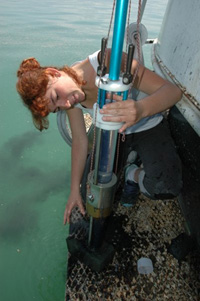Mercury remobilisation and methylation in sediments by bacteria
Summary : Mercury remobilisation of previously consolidated sediments can cause significant perturbations in the environment that are not fully understood yet and, hence, needs to be studied in more detail. The main goal of the present research is to understand mercury and methylmercury mobilization by bacteria from the sediments to the water column in order to determine if the sediments are a source of methylmercury and what biotic processes are involved. The latter implies to study Hg partitioning in sediment and interstitial water and its relationship with bacterial process.

State of the art: Hg is a natural and widespread trace metal occurring in the environment. However, in severely exposed humans, this metal is a hazardous contaminant, which damages the central nervous system. Industry is an important source of Hg pollution. Once in the aquatic systems, this high reactive pollutant accumulates in bottom sediments, which are considered as the main site for the methylation of Hg by sulphate reducing bacteria and/or ferrireducing bacteria. Monomethylmercury (MMHg) is the most dangerous form of Hg which attracted the international attention of the scientific community because of its bioavailability, toxicity and biomagnification in the aquatic food chain. Historically, the effects of MMHg intoxication on humans have been well documented after the disasters of Minamata and Irak. The effects of MMHg biomagnification in the food chain can be observed for a long time after the factories stopped using Hg technology. The most serious symptoms of mercury intoxication are ataxia, sensory disturbances, tremors, impairment of hearing and difficulty in walking. The mortality in Minamata was 44% percent due to mercury intoxication by fish consumption in 1965 (WHO 2002). Fifty years after, the patients with chronic MMHg poisoning (Minamata disease) have somatosensory disorders even after discontinuation of exposure. Reservoirs, located close to the cities and downstream industrial areas, accumulate sediments from anthropised catchments and consequently the bounded pollutants. Reservoirs can be also important sources of fish for the local population. The consumption of Hg contaminated fish still remains the most common exposure pathway of MMHg for humans.
Objectives : This project aims to understand how MMHg in methylated and transferred from the sediments to the water column, particularly in the Babeni reservoir, a high Hg-contaminated reservoir. To attempt it, three studies will be carried on in parallel
- To determine the MMHg concentrations in water column and suspended matter in Babeni reservoir, Valcea reservoir and the reservoir located downstream Babeni.
- To evaluate the methylation in sediments (MMHg fluxes and bacteria activity).
Study Sites : The Babeni reservoir in Romania. A chlor-alkali plant releases Hg in a section of the Olt River, a tributary of the Danube River.
The Bay of Vidy, Switzerland. Study of the contamination by the effluent of a STP (sewage treatement plant)) in Lake Geneva.
The Wettingen reservoir.
Framework/Financing : Swiss National Science Foundation.
Collaborations : Jakob Zopfi: University of Neuchâtel.
David Amouroux, Laboratory of analytical and environmental chemistry of the University of Pau, France.
Supervisor and colleagues directly involved :
Supervisors of thesis: Janusz Dominikand Walter Wildi.
Collaboratrice involved: Andrea Garcia Bravo
